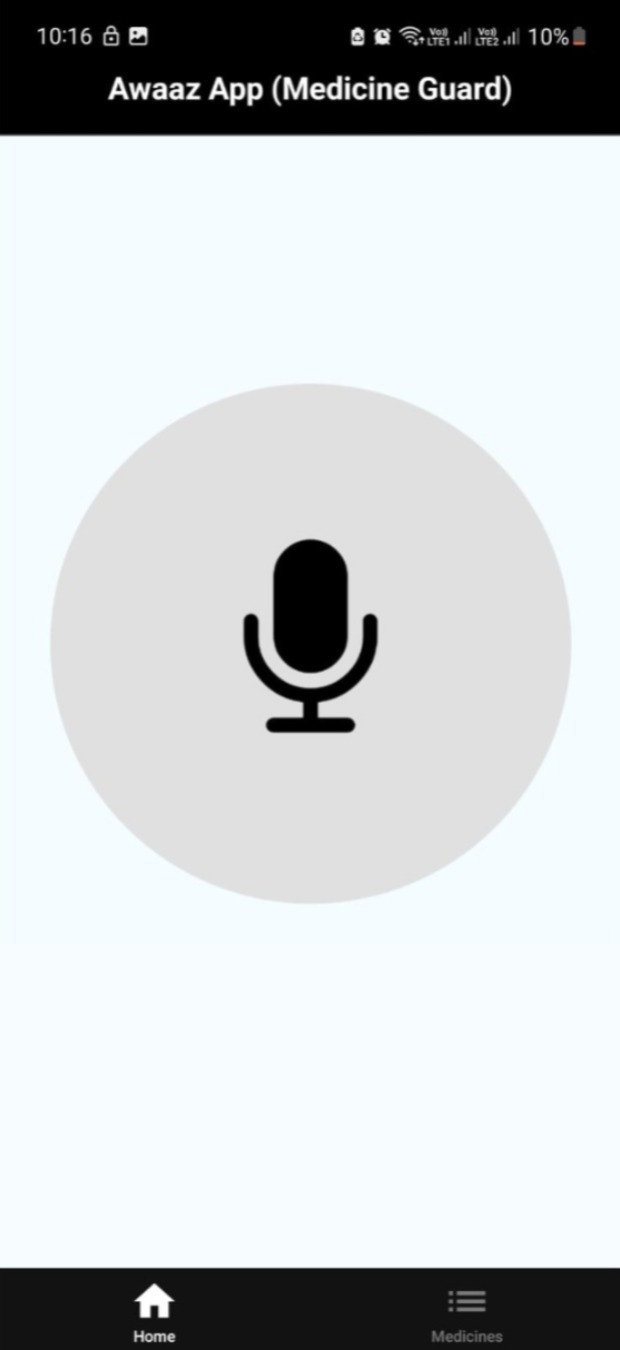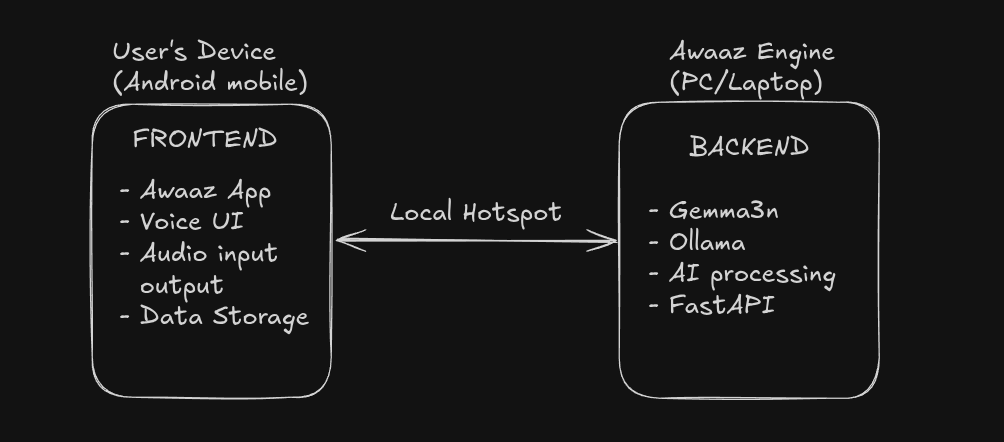Awaaz is a fully offline, voice-first AI health companion built for blind and visually impaired users. Unlike mainstream assistants, Awaaz works entirely without the internet, delivering privacy, independence, and critical health reminders-even in rural and low-connectivity areas. Built for the Gemma 3n Hackathon, my mission is simple: Empower users too often ignored by big tech.
To fully experience Awaaz, use an Android device + a secondary device (PC or Android phone) as described below.
-
Impact & Vision: Offline AI health support for blind users; privacy-first, built for real-world needs.
-
Video Pitch & Storytelling: Engaging demo focused on accessibility and user experience.
-
Technical Depth & Execution: Fully functional offline AI using Gemma 3n and Ollama; robust, accessible engineering.
Main screen - voice-first, minimal UI for accessibility
Medicine list screen – medicines and timings visible via voice and audio cues
Awaaz is a two-device, peer-to-peer voice assistant system that empowers blind users to manage their health through natural conversation. It provides medicine reminders with empathetic dialogue-powered entirely offline using Google’s Gemma 3n model.
- Primary Device: Android phone (the blind user's device) running the Awaaz app.
- Secondary Device: PC (or any Linux/Mac/Windows computer) running the "Awaaz Engine" backend (Ollama with Gemma 3n).
(Edge devices like NVIDIA Jetson are planned for future releases.) - Connection: Local Wi-Fi hotspot - No Internet Required.
- True Offline Voice AI: All processing happens locally-no user data ever leaves their hands.
- Privacy by Design: No cloud processing, no third-party data sharing, ever.
- Real Accessibility: Designed based on interviews with blind students-fully audio, screen reader compatible, feedback on all actions.
- Voice Commands: Natural language processing with cancel/clear support.
- Audio Feedback: Text-to-speech responses and audio cues for every action.
- Medicine Reminders: Notification system for scheduled medication times.
- Hotspot Connection: Direct, peer-to-peer app-to-engine link (no router needed).
- Recording Validation: Smart feedback for very short or failed voice recordings.
- Accessibility First: Designed for simple, voice-first interaction and minimal visual clutter.
- Python 3.8+
- FastAPI
- Uvicorn
- Ollama (with Gemma 3n model)
- Required Python packages (
requirements.txt)
- Node.js 16+
- Expo CLI
- React Native development environment
- Android device or emulator
- Expo Go app (for local testing)
-
Clone the Repository
git clone https://github.com/abhishekblue/gemma3n-hackathon.git cd gemma3n-hackathon -
Create Virtual Environment
python -m venv venv source venv/bin/activate # On Windows: venv\Scripts\activate
-
Install Python Dependencies
pip install -r requirements.txt
-
Install Ollama & Gemma 3n
# Install Ollama curl -fsSL https://ollama.ai/install.sh | sh # Pull Gemma 3n model ollama pull gemma3n:e2b-it-q4_K_M
-
Setup STT and TTS Models
-
Speech-to-Text (STT):
Download and place the Vosk modelvosk-model-en-us-0.22-lgraphin thestt-model/directory. -
Text-to-Speech (TTS):
Download and place the Piper modelen_US-hfc_female-medium.onnx.jsonin thetts-model/directory. -
(See the Vosk and Piper documentation for more on downloading and setting up these models.)
-
-
Start the Backend
uvicorn main:app --host 0.0.0.0 --port 8000
-
Navigate to the App Directory
cd awaaz-app -
Install Dependencies
npm install
-
Install Expo CLI Globally (if not already installed)
npm install -g @expo/cli
-
Start Development Server (optional)
npx expo start
-
Production Build:
- Build Android APK (
eas build -p android) or use Expo Go for quick testing.
- Build Android APK (
- Create Hotspot: Enable hotspot on the secondary device or use a shared local network.
- Connect Primary Device: Connect your Android phone to the hotspot or local network.
- Configure IP: Enter the backend device's IP in the Awaaz app settings.
- Test Connection: Ensure backend and app can communicate (see Troubleshooting below).
The mobile app requests:
- Microphone Access: Voice commands
- Notification Permission: Medicine reminders & alerts
If permissions are blocked, enable them manually in Android Settings → Apps → Awaaz-app → Permissions.
- Start the Backend on the secondary device.
- Connect Both Devices to the same hotspot or local network.
- Set Backend IP in Code:
The backend IP address is hardcoded in the app’s source code.
Before building the APK, update the IP address wherever it appears in the code. - Build and Install:
Rebuild the APK usingeas buildand install it on your Android device. - Use Voice Commands: Tap the mic button and speak naturally.
- Experience Audio Feedback for all actions.
Note: In this MVP, the backend IP is hardcoded in the app source code. A user-editable option is planned for future versions.
Command Controls:
- Say “cancel” or “clear” to interrupt any operation.
- Very short voice recordings trigger an instant audio prompt.
gemma3n-hackathon/
├── backend/ # FastAPI backend (Ollama/Gemma 3n integration)
│ ├── main.py
│ ├── stt-model/
│ ├── tts-model/
│ └── requirements.txt
├── awaaz-app/ # React Native frontend (Android)
│ ├── app/ # Main navigation and screens
│ │ ├── (tabs)/
│ │ ├── assets/
│ │ ├── components/
│ │ │ └── ui/
│ │ ├── utils/
│ │ └── ...
│ ├── app.json
│ ├── eas.json
│ ├── package.json
│ └── ...
└── README.md
Audio cues for every interaction:
- ding.mp3 - Recording start sound
- ending.mp3 - Converstaion finished sound
- processing.mp3 - Processing feedback sound
- 100% offline-perfect for privacy and rural users.
- All AI processing on local hardware (via Ollama + Gemma 3n).
- STT & TTS models run locally.
- All user data stays on device.
- Primary Device: Android app (can be tested via Expo on PC)
- Secondary Device: PC or Android phone with Ollama/Gemma 3n backend
- Connection: Local hotspot network
- Deployment: Mobile APK + backend setup
Awaaz is not just a hackathon project-here’s how it can grow:
- Prescription Image Recognition (phone camera integration)
- Integration with Government Health DBs (for verified medication data)
- Multi-lingual Support (Hindi, Tamil, and more)
- NVIDIA Jetson/Edge Device Support (super-portable, low-power deployment)
- Community Feedback Loop: Continuous improvement from real blind users and NGOs
Common Issues
- Connection Failed: Check both devices are on the same network.
- IP Address Issues: The backend device’s IP address may change if it’s assigned dynamically. Always double-check and update the hardcoded IP before building the APK.
- Firewall Blocking Connection: Ensure your PC firewall (e.g., Windows Defender) or any antivirus is not blocking port 8000 or local network traffic.
- Audio Not Playing: Check phone volume, permissions, or Android settings.
- Backend Not Starting: Ensure port 8000 is free; run as admin if needed.
- Ollama Issues: Confirm Gemma 3n model is downloaded and running (via
ollama serve). - Model Loading Issues: Make sure STT/TTS models are present in the right folders.
Debug Commands
# Check backend status
curl http://YOUR_IP:8000/
# Check Ollama status
ollama list
# Backend logs
uvicorn main:app --host 0.0.0.0 --port 8000 --log-level debug
# Mobile app logs (Expo)
expo start --clearThis is a hackathon project, but contributions for accessibility improvements are welcome!
MIT License - Feel free to use this project to help the visually impaired community.
Developer: Abhishek Jain Email: jainabhishekjain007@gmail.com GitHub: https://github.com/abhishekblue
Made with care for accessibility and inclusion. Empowering blind users through voice technology.
Hackathon Submission: Google - The Gemma 3n Impact Challenge Repository: https://github.com/abhishekblue/gemma3n-hackathon


